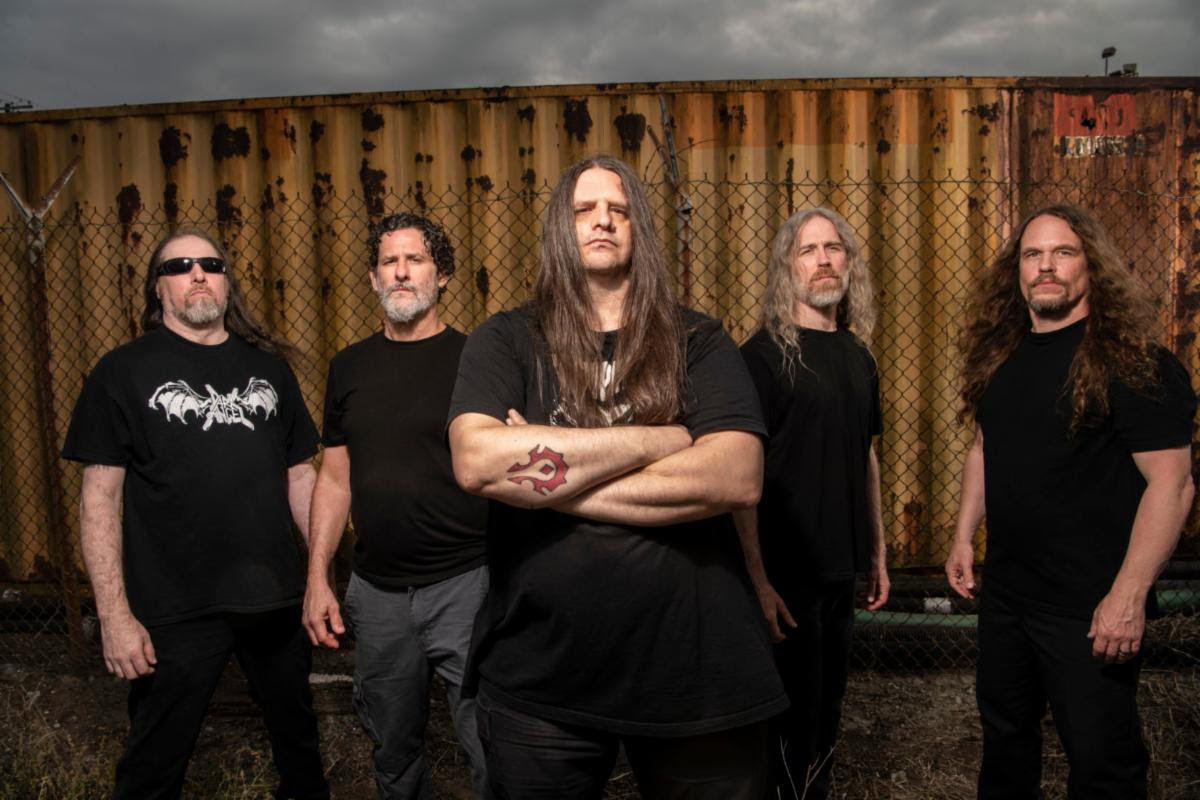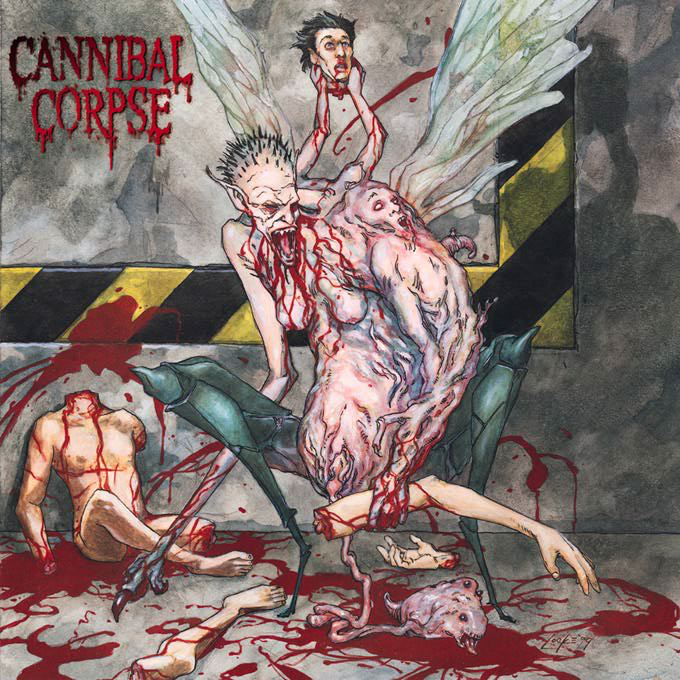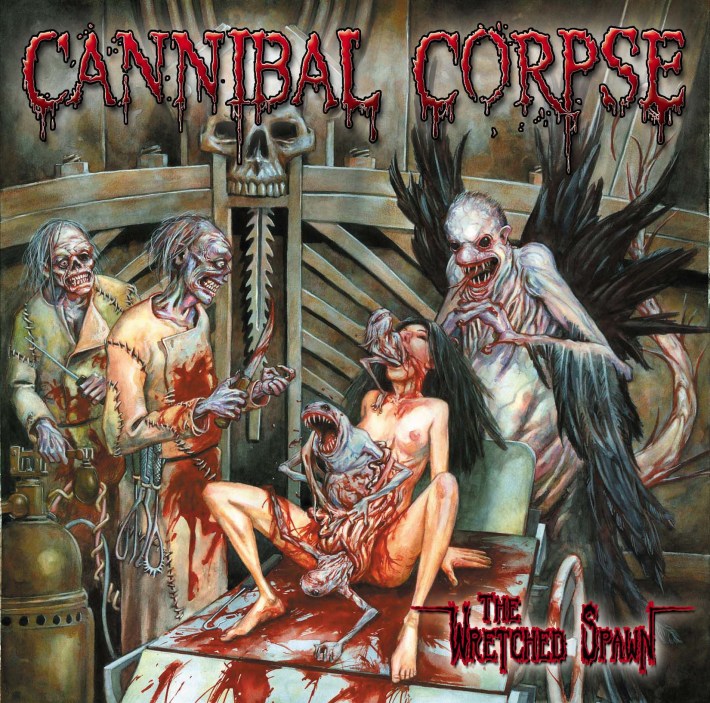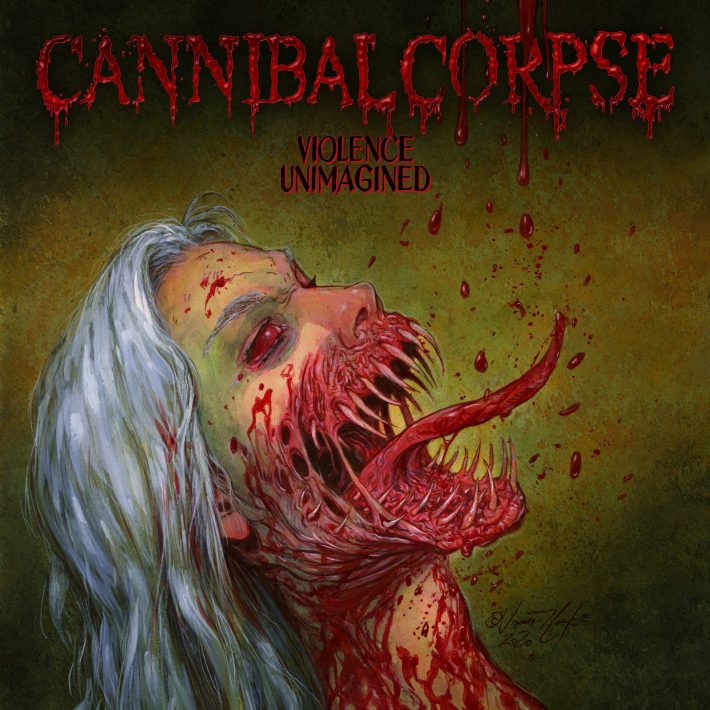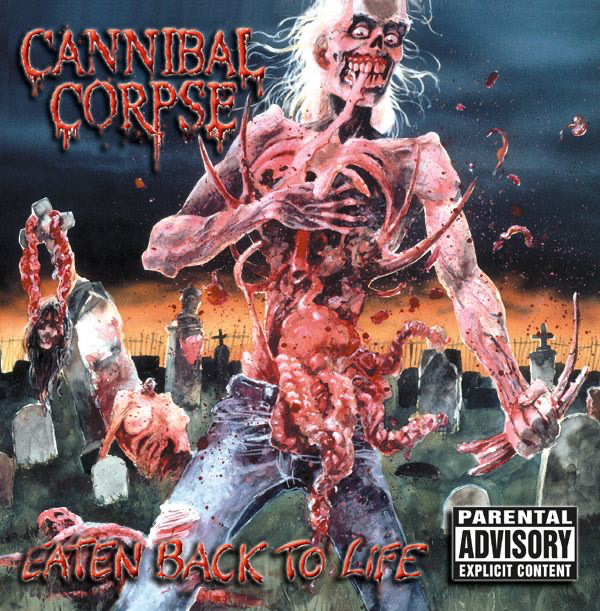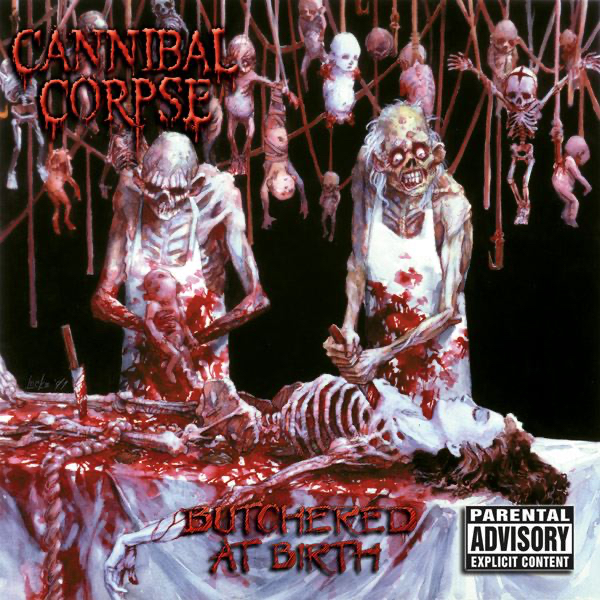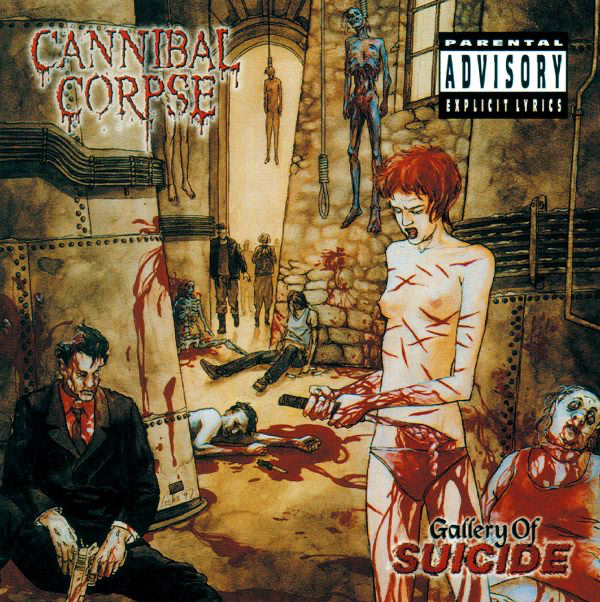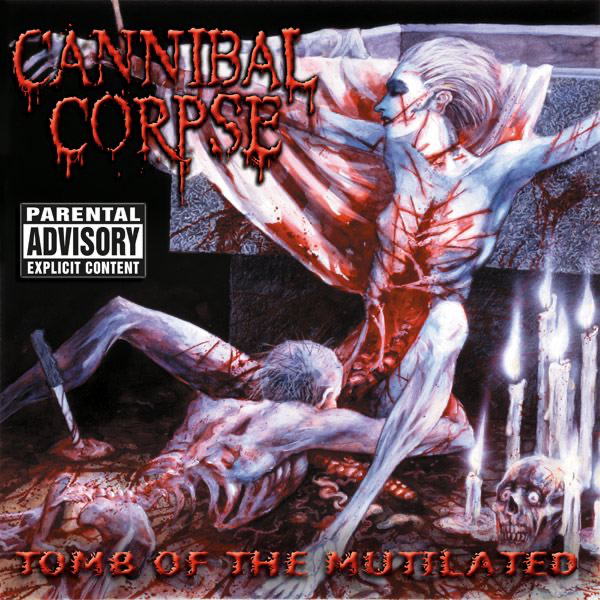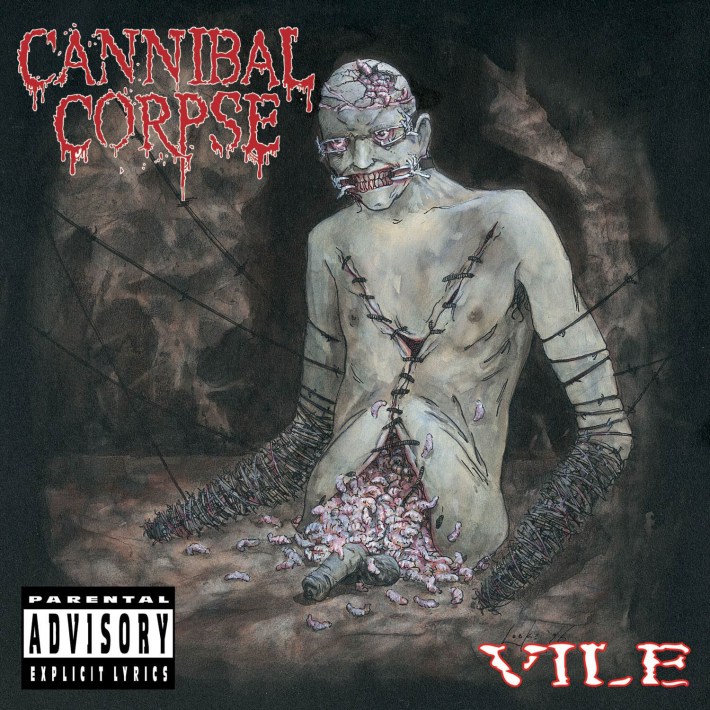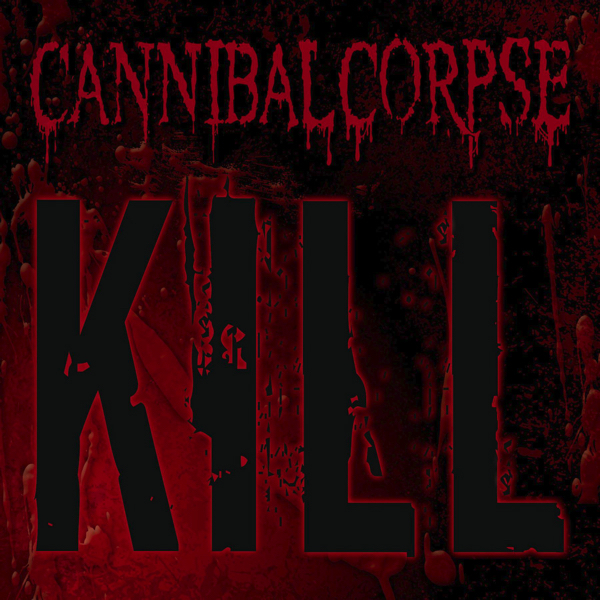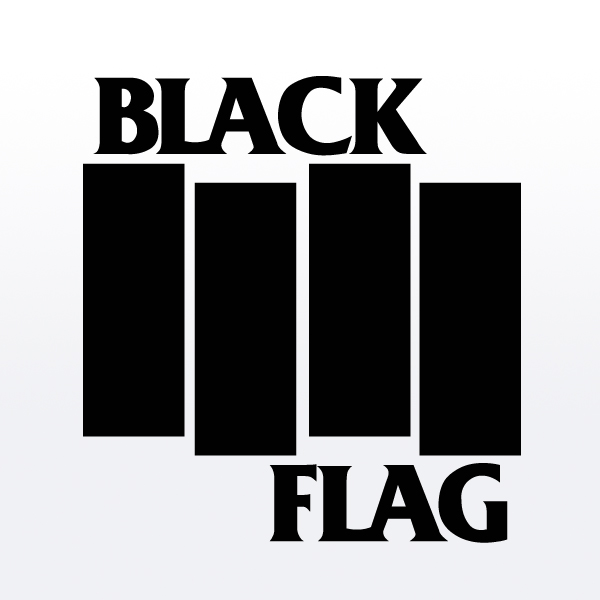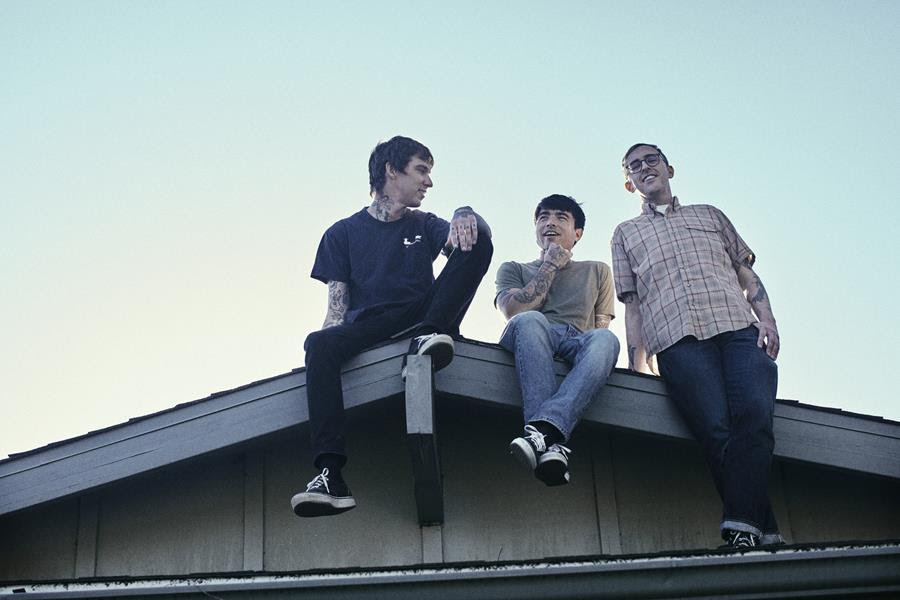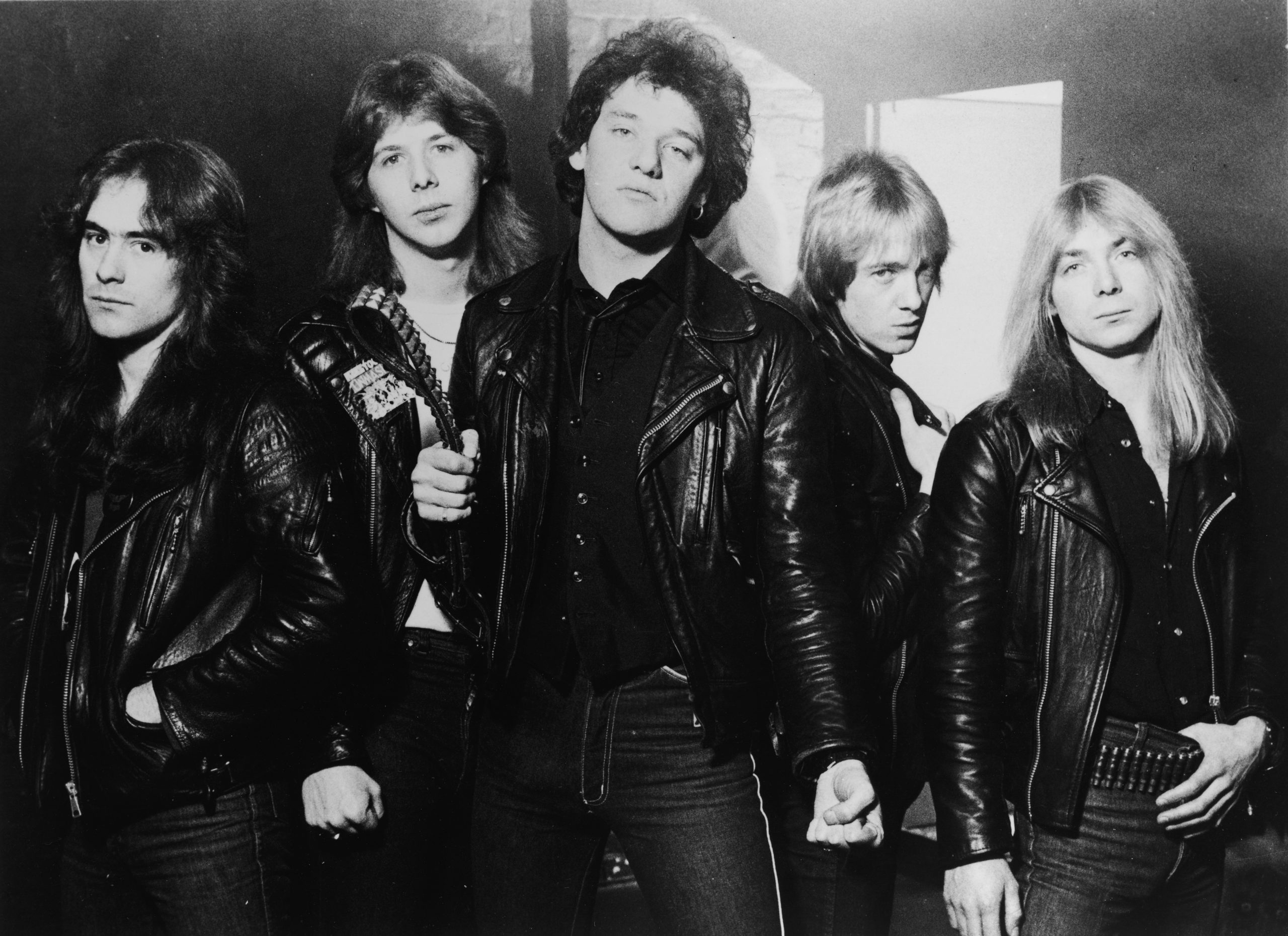Death metal is defined in large part by its extremity, so perhaps it stands to reason that the genre’s most provocatively off-putting band is also its most commercially successful. Buffalo, New York’s Cannibal Corpse released their first album, Eaten Back To Life, in 1990. Four years later, they would appear in the $100-million-grossing Jim Carrey vehicle Ace Ventura: Pet Detective at the behest of the rubber-faced comedian, an avowed fan. Two years after that, they’d crack the Billboard 200. Their 15th album, Violence Unimagined, went all the way to #6 back in April, and they’re now widely considered the best-selling death metal act of all time -- quite a feat for the dudes who wrote "I Cum Blood."
Eaten Back To Life was the gruesome opening salvo that introduced the world not only to Cannibal Corpse but to the stomach-turning artwork of Vincent Locke. The underground comics artist behind Deadworld had found his perfect subject in the band's ultraviolent lyrical imagery, and their ongoing collaboration continues to this day. The cover for Eaten is archetypal of Locke and Cannibal Corpse’s creative partnership, with its depiction of a stringy-haired zombie devouring his own eviscerated guts. (It also has the Kourtney Kardashian seal of approval.) Locke would soon up the ante with far less tasteful covers, which, of course, would only win Cannibal Corpse more fans.
While they were amassing those fans, Cannibal Corpse were also making enemies, including some powerful ones. Efforts by US activists to get Metal Blade to sever their relationship with the band fell flat, but their music was successfully banned for years in Germany and Australia. In Germany, an injunction against the band even prevented them from playing songs from their first three albums. George "Corpsegrinder" Fisher, who did not sing on those records, noted the absurdity in a 2004 interview with Chicago Innerview: "We can’t play ‘Born In A Casket' but can play ‘Dismembered And Molested.'"
Here’s the part where I concede that some of Cannibal Corpse’s lyrics and artwork are, in fact, a little beyond the pale. Every song in the band’s discography depicts extreme violence, but few are interested in excavating its trauma, which means the less cartoonish the lyrics, the ickier they feel. That's not an argument for censorship, but it is a fair warning that diving deep with Cannibal Corpse’s catalog is going to mean seeing and hearing some things that don’t necessarily hold up in 2021. The rankings below reflect that a bit, but in general, this is a list for people who know what they're getting into. You’re either the kind of person who has the capacity to love a song called "Blunt Force Castration" or you’re not. With that in mind, here are the death metal kings' albums ranked worst to best.
This is the one album whose ranking is based on how poorly it holds up. "Stripped, Raped, And Strangled," "Fucked With A Knife," and "She Was Asking For It" moved explicitly sexual violence from the margins of Cannibal Corpse’s lyrics to center stage. The band’s post-Ace Ventura effort to clean up their production for a broader audience rendered Chris Barnes' voice crystal-clear for the first time, a choice that meant their most grotesque lyrics to date were also their most legible. (Barnes would be ousted the following year and replaced with George "Corpsegrinder" Fisher.) The tasteless lyrics weren't the only problem with The Bleeding. The sterile production doesn’t work for Cannibal Corpse’s sound, and guitars that should sound like buzzsaws sound flat and distant. There are diehard fans who consider this the best Cannibal Corpse record. To each their own. It’s the only one I never want to listen to.
Torture is the top-heaviest Cannibal Corpse album, with fan favorite "Scourge Of Iron" heading up a collection of frustratingly generic tunes. "Scourge" is brilliant, a menacing, stalking beast of a song that sees Cannibal locked into one of their signature slow grooves for most of its duration, doling out its few rapid-fire bursts as exclamation marks. It stands in stark contrast to the rest of the album, which too often feels like it’s on autopilot. Cannibal are too good at what they do for Torture to be outright bad, but it fails to connect beyond the lizard brain reaction.
An oddly muted production job by the otherwise peerless Erik Rutan holds Evisceration Plague back from the upper echelon of the Cannibal discography, but it does have a few top-tier songs — the album (and pit) opener "Priests Of Sodom," the sub-two-minute attack of "Scalding Hail," the stomping title track. With a punchier drum sound and beefier guitars, Evisceration Plague might place a lot higher, but it doesn’t knock the wind out of you the way the best Cannibal Corpse albums uniformly do. It also has the worst cover art of any Cannibal release, and for a band whose visuals are so thoroughly woven into the fabric of everything they do, that has to be taken into consideration.
Gore Obsessed was the fourth Cannibal Corpse album with Corpsegrinder on vocals, which meant the new guy had officially been in the band for as many records as the former guy. By this point, Corpsegrinder had fully integrated himself into the Cannibal sound. His staccato barking and punctuating high screams fit the way the band’s songwriting was evolving better than Chris Barnes’ broken-glass-gargling gutturals would have, and Gore Obsessed is a sinewy continuation of the streamlining their music was undergoing. That renders some of the ideas here a little underdeveloped, but "Pit Of Zombies" and "When Death Replaces Life" suggest the more… well, not mature, but more developed sound Cannibal would explore in the following decade.
Bloodthirst is Cannibal Corpse at their most direct: 11 songs, 34 minutes, ripper after ripper after ripper. Its highs aren’t quite as high as on the finest Cannibal records, but it makes up for that with pound-for-pound might. There’s not one bad song on Bloodthirst, and the anarchic momentum that carries it forward makes it feel like the most punk Cannibal album. There are zero moments of introspection. It wants you to bang your head for its entire duration. When that’s the vibe you’re chasing, accept no substitute.
The seams are visible on The Wretched Spawn. It’s a transitional album, one that sees the straight-for-the-jugular intensity of the early Corpsegrinder era start to twist itself into something more technical. This version of the band wouldn’t become fully realized until they teamed up with engineer Erik Rutan for 2006’s Kill, but the groundwork that The Wretched Spawn lays is fascinating in its recklessness. "Festering In The Crypt" and "They Deserve To Die" wield their sonic cruelty with nuance and complexity, and even the blasting, straightforward songs seem to chafe at their restraints. Spawn doesn’t fully cohere, but it’s exciting and restless in a way Cannibal Corpse haven’t always been.
"Fire up the chainsaw/ Hack their fucking heads off!" is the best singalong moment at any Cannibal Corpse concert. "Kill Or Become" hasn’t left the setlist since 2014, and it never fails to whip the crowd into a frenzy when it reaches its gloriously juvenile chorus. It makes you want to Leeroy Jenkins your way into a scrum of zombies in Left 4 Dead. "Kill Or Become" is the best song on the rock-solid A Skeletal Domain, the album that started the band’s ongoing hot streak. There’s something to be said for professionalism in a long-running band. The current version of Cannibal Corpse knows exactly who they are, and the process they’re undergoing is one of refinement, not reinvention. A Skeletal Domain is symbolic of that effort.
In 2018, Cannibal Corpse guitarist Pat O'Brien was arrested on burglary and assault charges. The details that emerged afterward were troubling, and it soon became clear that O'Brien was dealing with unaddressed mental health issues. O'Brien’s arrest meant his exit from the band, but out of that mess came a silver lining. Erik Rutan, the Hate Eternal guitarist who had been with the band as a producer since 2006, was joining Cannibal Corpse. For death metal guitar nerds, this was the equivalent of Kevin Durant signing with the 73-win Warriors. Rutan's first Cannibal album as a full member was Violence Unimagined, and it took full advantage of his talents. His shredding, meticulous solos breathed new life into the band, and his perspective as a songwriter broadened their lyrical palette. The pandemic horror of "Condemnation Contagion" might be the first time Cannibal Corpse have engaged with current events on one of their records. With Rutan onboard, it feels like Cannibal will last another three decades.
On their debut album, Cannibal Corpse were discovering death metal along with everyone else. Death had just kickstarted the scene in earnest three years earlier with 1987's Scream Bloody Gore, and the bands following in their wake studied and augmented that album's blueprint to help mold the nascent genre. Eaten Back To Life sounds raw and primordial in the way a lot of those early death metal albums do, and while it lacks the je ne sais gore that made Cannibal's later work indelibly their own, it's still a hell of a ride. The band's pet lyrical proclivities were already in place, at least. "Edible Autopsy," "Scattered Remains Splattered Brains," and "A Skull Full of Maggots" are classic Cannibal Corpse titles, and the fierce, chaotic songs they’re attached to teeter, thrillingly, on the brink of collapse.
The beginning of "Meathook Sodomy" is the most musically experimental passage in Cannibal Corpse's discography. For 80 horrifying seconds, seasick guitars churn in a spiraling pattern without percussion, while Chris Barnes wordlessly moans out an inhuman, guttural growl, several octaves lower than anything he had done on Eaten Back To Life. That's how Cannibal Corpse chose to open their sophomore album, Butchered At Birth. It was a provocation, but also an annunciation. This was no longer simply a horror-themed death metal band and peer to groups like Deicide and Obituary. This was the most extreme, disgusting death metal band in the world. Vincent Locke's grisly cover art depicted zombie surgeons performing an abortion on a corpse in an image that was broadly censored even as it was becoming perversely iconic. Eaten Back To Life is a killer death metal album, but Butchered At Birth is the first great Cannibal Corpse record.
There’s not a better three-song run on a Cannibal Corpse album than the trifecta that kicks off Red Before Black. "Only One Will Die," "Red Before Black," and "Code Of The Slashers" comprise a masterclass syllabus for everything that makes late-era Cannibal great. Machine-gun riffs? Check. Off-kilter rhythmic pounding? Yep. Menacing, nasty grooves? Oh yeah. Wildly flailing guitar solos? Duh. Lyrics about horrific violence delivered in a cadence that gets them stuck in your head? Dude. All three tracks became immediate live favorites, and it's not hard to see why. They're the sound of a band so locked into what they do best that the songs seem to spill out fully formed. The rest of the album miraculously manages to keep pace with the opening trio, from the bass-shred highlight "Scavenger Consuming Death" to the dark, churning "Hideous Ichor." Red Before Black is on an incredibly short list of the greatest 14th albums of all time.
When Corpsegrinder joined Cannibal Corpse for 1996's Vile, the songs were mostly written already. If Chris Barnes had been able to keep the tension between him and the rest of the band under control a few months longer, he would have appeared on the album. Gallery Of Suicide was the first Cannibal record fully conceived with Corpsegrinder in the band, and it vibrates with the joy of what their new singer could do. The album plays like his resumé for the position of greatest death metal vocalist of all time. Barnes was gifted as an ultra-low growler, but Corpsegrinder could match him there with ease. He also added piercing high screams, rapid-fire patter, clear enunciation, and the versatility to dart between styles within a verse or even a line. All of that is on display on Gallery Of Suicide, and classics like "I Will Kill You," "Sentenced To Burn," and "Centuries Of Torment" are showcases for his stunning voice. Ironically, Gallery Of Suicide also includes the only truly essential instrumental track in the Cannibal discography in the moody, proggy "From Skin To Liquid."
If you find yourself wondering how The Bleeding finds itself in dead last on this list for its tastelessness, but Tomb Of The Mutilated sits in the top three despite being home to "Necropedophile" and "Addicted To Vaginal Skin," well, welcome to Cannibal Corpse fandom. It is a place fraught with contradiction, but the riffs are excellent. There’s an invisible line between the Grand Guignol absurdity of a song like "I Cum Blood" and the more disquieting violence of The Bleeding, and Tomb mostly stays on the right side of it. More crucially, you can’t understand what the hell Chris Barnes is saying at any given point on the album, which only helps some of its least defensible lyrics. None of that explains why it’s up this high, though. Tomb Of The Mutilated is the third best Cannibal Corpse album because all 10,000 of its riffs are fucking perfect. The interplay between guitarists Jack Owen and Bob Rusay is the finest it ever was in their shared stint in Cannibal, with Owen's right hand bashing out rhythmic brain-benders while Rusay reaches deep in his bag for expressionistic, stabbing leads. "Hammer Smashed Face" is the band's most famous song for a reason, and its breakdown is the most afraid I’ve ever felt in a mosh pit. Tomb is beyond reproach.
George "Corpsegrinder" Fisher announced his arrival in Cannibal Corpse with a blood-curdling scream. You can feel the opening roar from "Devoured By Vermin" in the pit of your stomach, which is where Corpsegrinder has lived ever since. Though Vile was written with Chris Barnes in mind, his replacement made it the masterpiece it is. Starting with that very first scream, his vocal personality shines through on every song, whether he’s anchoring an atmospheric song like "Bloodlands" in his earthy growl or spitting a hundred bars a minute like he does on "Puncture Wound Massacre." Behind Corpsegrinder and the flashy dual guitar attack of Jack Owen and Rob Barrett, the quiet MVPs of every Cannibal Corpse album are in top form. Bassist Alex Webster and drummer Paul Mazurkiewicz are the only people who have played on every Cannibal release, dating all the way back to their lone pre-LP demo tape. They’ve never been less than stellar, but on Vile, their ability to keep the band’s chaotic vortex from spiraling out of control is particularly impressive.
It’s not easy to pinpoint exactly what makes Kill, Cannibal Corpse’s 10th studio album, their best. Superficially, it looks a lot like every other Cannibal Corpse record. It has relentless fast songs and bludgeoning slow ones, streamlined heaters as well as slyly progressive curveballs. Its lyrics invent a few new grisly methods of murder — "Submerged In Boiling Flesh" wins in creativity, but "Five Nails Through The Neck" beats it for specificity. What gives Kill the edge over every other sonic torture device in the Cannibal discography is how vividly it renders its familiar terrors. The 2006 album marked the band’s first time working with recording engineer (and current Cannibal guitarist) Erik Rutan. Almost two decades in, they had finally found a producer who could make their recorded work match the intensity of their peerless live show. In his hands, a straightforward song like "The Time To Kill Is Now" became a tactical weapon, a vibrant barrage where every note was audible, and every note wanted to execute you. The band lived up to their new collaborator's high standard, delivering 13 flawless songs. The solos are as liberated and wild as the riffs are disciplined and tight, and Corpsegrinder delivers the best vocal performance of his career. "Make Them Suffer" was even a minor MTV hit on the resurrected Headbanger's Ball, putting Cannibal in front of a new generation of fans too young to have watched America get scandalized by Tomb Of The Mutilated. For once, the kids got the better end of the deal. Kill is the best Cannibal Corpse album.
